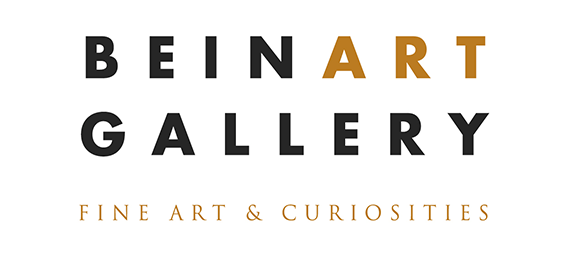
“The Gilded Wilderness” (2012) - Oil, gold & silver leaf.
These days it's a cherry on top when a conceptual artist has impeccable technical skills, and is able to play with various painting tools to alter the viewer's state of mind. Artist Brad Kunkle has this ability. There is quite a lot going on beneath the surface in each of his luscious paintings. He purposely uses a limited palette and overcast light source to flatten his imagery. It’s a trick painters use - both colour and light are elements in painting, which can be used to create the illusion of depth on a two-dimensional surface. Yet his works depict a wonderfully rich depth and motion. His use of contrast, gesture and composition guide the viewer’s eye and emotions through his impossible landscapes. The subjects of his works, almost exclusively female, lure their viewers in with their gaze and idealistic beauty. His use of metallic leaf is unique, reflecting light in just the right way to play with the threshold between two and three dimensions helping viewers pass from a world where they stand sure footed, to a dreamy, foggy place.
"When I gild a sky in a painting, the reflected light on the leaf is a direct connection to the passing of time of light in the viewer's reality." —Brad Kunkle

“The Belonging” (2014) Oil, gold and silver leaf.
Samantha Levin: Can you define "Realism" for the purposes of this interview? I think there are many different perceptions of it. When I think of Realism, I think of Eakins. Others think of artwork that looks like an unretouched photo. What's your take?
Brad Kunkle: Realism to me is any form of painting that allows the viewer to easily identify the subject, excluding abstracted or heavily expressed forms... and the subject is rooted in reality. (Because we can’t put Dali’s work into realism, even though we can easily identify the subjects). I think of realism as including everyone from John Singer Sargent to Ingres.
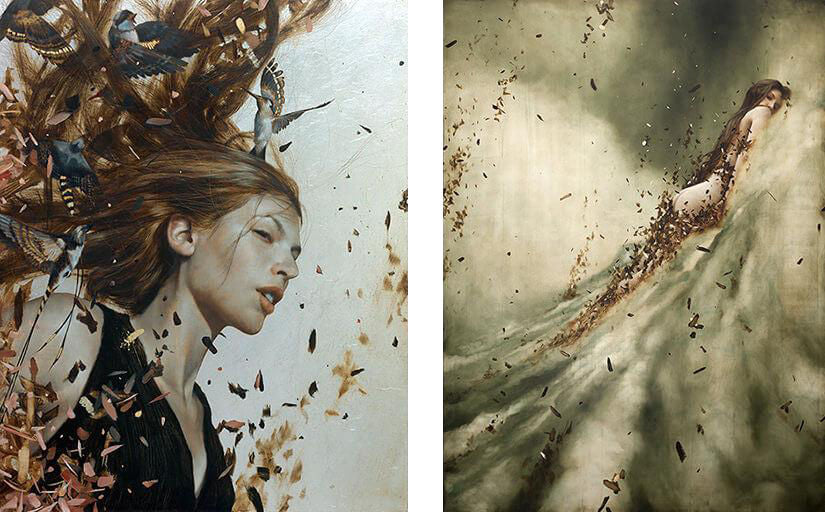
“Magnetic Fields” (2014) - Oil, gold & silver leaf & “Tidal” (2014) - Oil & gold leaf.
SL: So, would you consider yourself a bit of a realist, or is there too much concept and emotion ingrained in your work?
BK: I think of myself as more of a symbolist or surrealist. There is more concept than meets the eye in most of my work. Realism doesn’t excite me enough to want to be a realist... but i guess some of my work appears simple enough to be considered realism.
SL: I would hope that your work wouldn’t appear simple to anyone. There is simply too much content in each of your paintings; not only imagery, but also emotion and idea. Am I correct in understanding that you found the rigorous art training you had at Kutztown to be constrictive? This echoes the sentiments of many artists. Do you feel like you could have avoided this training or are you thankful you went through it?
BK: Actually I didn’t really find it constrictive... my advanced painting professor, George Sorrels, didn’t even require us to show up for class... only for the critiques. I’m grateful for that training... the core and fundamental classes are important... it’s all about learning techniques but then being able to, at some point, step away from the rigorous art training, and unlearn all the things that you don’t connect with as an artist.

“Islands” (2012) - Oil & gold leaf
SL: Light seems to be very meaningful in your paintings. Would you consider it to be a major subject or one of the basic underlying tools that brings out the figures and other objects you’ve depicted?
BK: Well, light indicates a passing of time... and I like the idea of keeping the light source vague because it lends itself to giving the paintings a sense of timelessness. Imagine yourself in a thick fog filled day... the fog lights up from almost everywhere... it’s very surreal and disorienting. When I gild a sky in a painting, the reflected light on the leaf is a direct connection to the passing of time of light in the viewer's reality... not the light that is defined by brush on the figure. This is best seen when natural light is coming through windows in a space where the painting may be hanging.
SL: You use photos as reference for your paintings. Have you ever shared your photos publicly? Is photography a medium you enjoy being creative with?
BK: I don’t really share them publicly. I don’t think they are particularly good... which is why I’m a painter... I just try to capture the light and form well on the skin... the rest is not that important. I usually make up the rest of the paintings from my imagination. I love being creative with my photos in photoshop. This is where I do a lot of very rough and silly looking mock compositions and “drawings” if you can call them that.
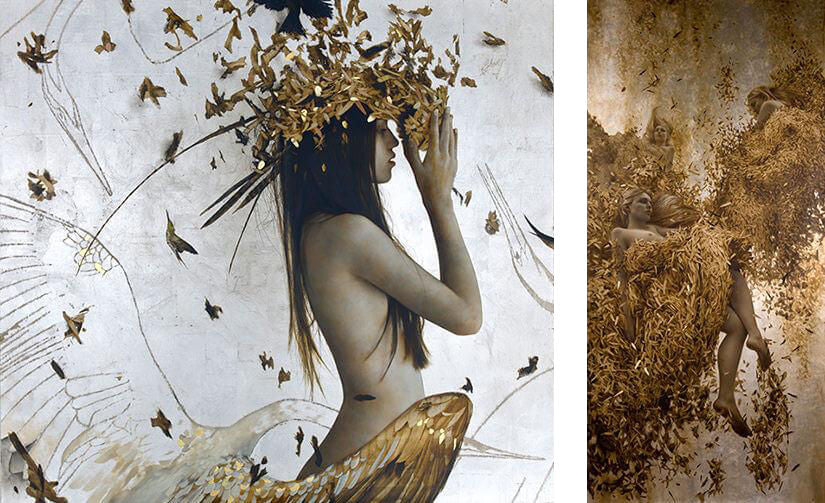
“The Near, Far and Leading” (2014) - Oil, gold & silver leaf & “Trinity” (2010) - Oil, gold & silver leaf
SL: Can you give me some background on what inspired you to create the installation "The Belonging?”
BK: Years ago I was at the Park Avenue Armory in NYC to see an Ann Hamilton exhibition called The Event of A Thread. While I was waiting in line to get in, I was looking at these massive 19th century oil paintings hanging in the lobby and was just unmoved. Then I entered the Hamilton exhibition, which had these giant swings that people could swing on... and they were attached by cords to giant sheets of white cloth hanging down from the ceiling. People were laying down under the white cloth, which quietly swayed like white waves... while kids and adults all waited to get their turn on a swing... so they could help make the waves and feel like a kid again. It was more complicated than this... but safe to say that by the time I left, I felt like there was so much more that I could be doing to affect the viewer’s experience than just painting. I also saw a Bill Viola retrospective in the early 2000’s that has always stuck with me... and James Turrell is possibly my favourite living artist. None of these artists are painters... and I’ve been deeply impacted and inspired by them.
SL: Are you referring to the Bill Viola retrospective that took place at the Whitney? I remember that blowing my mind. It was incredibly immersive and powerful.
BK: Yes! It was at the Whitney... and it had the same effect on me. I hadn’t even really started painting when I saw this. I was just a student learning fundamentals.
SL: What challenges did you encounter when making the installation? Was it difficult to move away from the comfort of the two-dimensional canvas?
BK: Well, I had to teach myself Final Cut Pro... and learn how to really be a bit of a filmmaker. I didn’t want to source any of this out to other people because I really didn’t know how it was exactly going to manifest in the end. The entire process, from filming the model, to editing, to figuring out if the projector could line up perfectly to the canvas and how bright it would be…. all of this informed the end result. I love working like this. I know where I want to go, but I only have general idea of how I’m going to get there. Making the map is more exciting than following the roads... and on that note… it was becoming difficult to stay within the comfort of the two-dimensional canvas... which is why I did this project.
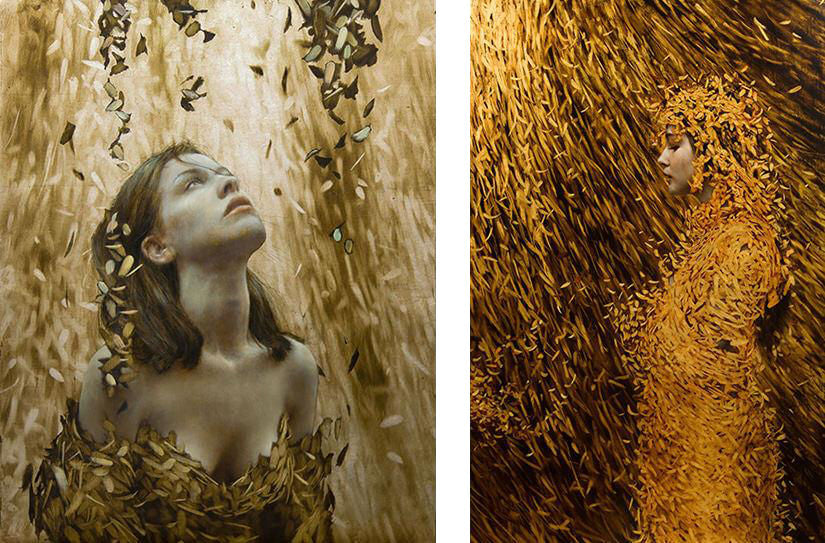
“Halfway” (2012) - Oil, gold & sliver leaf & “Cocoon” (2012) - Oil & gold leaf
SL: Is there a story that the work is telling or is it not so linear?
BK: It’s less of a story and more of a visualisation of a mythology. [Mythologist] Joseph Campbell talked about something he called “detribalisation”. It’s the idea that we could spend our whole lives being exactly what’s expected of us from the society or religion we are born into... or we could truly find our own identity, without these dogmas and expectations that have been dictated to us by other people, by listening to our own truth and intuition and nature.
SL: Is it accurate to say that you’re detribalising yourself by stretching into this new medium?
BK: Ha... well, I suppose that’s true. I never thought of that... but yes.

“Seer” (2012) - Oil & gold leaf
SL: The music in the installation is very spiritual and seems to be based on Indian harmonic drone. What was your interest in this kind of music?
BK: I’m unfamiliar with Indian harmonic drone... but Matt Taylor and I worked very hard to keep the music minimal and just “feel” right. I suppose whatever it was we felt... that note… is the same drone that is in Indian harmonics that feels spiritual.
SL: You’ve said that you greatly admire the work of artist James Turrell. His work is vastly different in style from your paintings. Besides the installation, has he influenced your work in any way?
BK: Well, his volcano project is my favourite piece. He’s influencing me by pushing me... pushing all of my work. Any artist that purchases an extinct volcano and builds a celestial observatory within it, that aligns with the moon every 18 years… that’s just incredibly brilliant and ambitious. And his intuition led him to the volcano. He was flying all over the country in a little plane, searching for this thing that he was looking for but wasn’t even quite sure what it was. If that’s not inspiring to every artist... to trust themselves... then I don’t know what is.
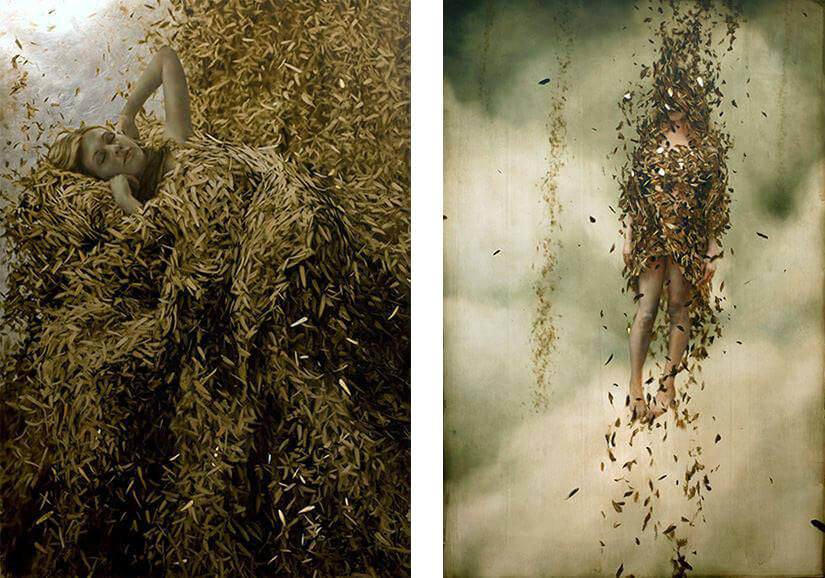
"Sixth Sleep” (2010) - Oil, gold & silver leaf & “True North” (2014) - Oil & gold leaf
SL: I have only seen his permanent work installed at PS-1 in Queens. While it never fails to inspire me, I feel like I have to see the ridiculously ambitious Roden Crater before I die. Any plans to make your way out there yourself?
BK: I’ve actually never been to the PS-1 installation... last I saw it was closed for restoration. Yes, Roden Crater is definitely on my bucket list. Sounds like for now, at least, it’s an invite only situation. Maybe I need to hit the lottery so I can donate a large sum of money to Turrell so he can finish it... then I’d probably get invited.

“The Daughters of Mandelbrot” (2011) - Oil and gold leaf
SL: It’s interesting that light also plays a significant role in the works of Turrell and Viola. Your work is visually vastly different from theirs, yet there’s this connection. I suppose light could be said to dominate any form of visual art. Any comment on that?
BK: That’s such a great observation. Yes. One of the reasons that I paint in a very limited palette, almost without colour... is the concept of truth. The true nature of an object or person or place. What I mean is, we can see a ball because there is light bouncing off of it. Remove the light, and it is gone. We don’t see it because it is yellow. Remove or change the colour, and we still see the ball, because it is still reflecting light. Let’s assume I’m colour blind, and we are both looking at the ball. We can argue all day over the colour of that ball, but we can both agree that it exists because we see the light on it.

“Mare Imbrium” (2012) - Oil, gold and silver leaf
SL: Light, more than color, defines form and depth for our eyes and brains.
BK: Every wavelength of light is perceived as a colour in the spectrum.... as a spectral colour. I’m talking about taking away ‘perception’ from the equation and leaving us with an elementary definition of light... like brightness and darkness. Colour happens in the brain, which is why we can all perceive it differently. I’m making an artistic and philosophical argument that we get a little closer to the “truth” of a subject if we take colour out of it. There is something so “truthful” and “timeless” about a black and white photograph. I don’t doubt it has something to do what we are talking about here. There is a whole physics debate to be had here because white light is a combination of wavelengths in the colour spectrum but I’m going a bit beyond science and speaking philosophically.
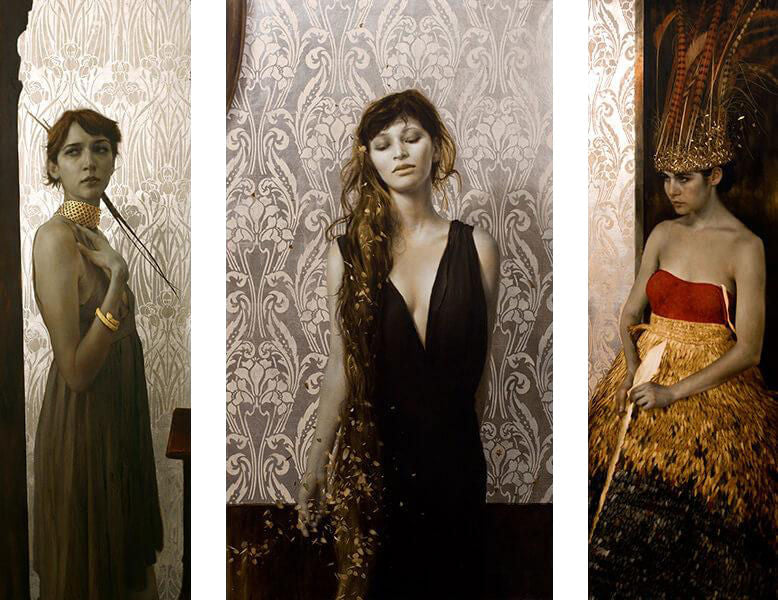
“The Gold Choker” (2010), “The Quickening” (2010) & “The Red Crown” (2012) - All oil, gold and silver leaf
SL: Tell me what projects or shows are coming up soon. Do you hope to create more multi-media installations?
BK: I’ll have a painting in a group show at Jonathan Levine in August. The show is all about imaginative realism and I hear there will be about 35 artists participating. I’ve also been invited to be the teaching guest of honour at the IMC at Amherst College this year and there is talk of a university residency in California forming for the fall. I definitely plan to continue creating more multi-media pieces. I think I just hit the tip of the iceberg with The Belonging.
SL: Looking forward to the show and whatever new projects you dive into. Thanks for the interview, Brad!

“The History of Nature” (2014) - Oil, gold and silver leaf
This interview was written by Samantha Levin for the Beinart Collective in 2015.
Samantha Levin spends much of her time working as a digital curator, archivist and librarian preserving rare art- and design-related materials. Also an artist and curator, she works with Contemporary Grotesque and dark artists, curating and producing group and solo pop-up exhibitions. She currently lives and works from her Brooklyn studio with the ghost of her white marshmallow-shaped cat, Luna.




 Cart
Cart


